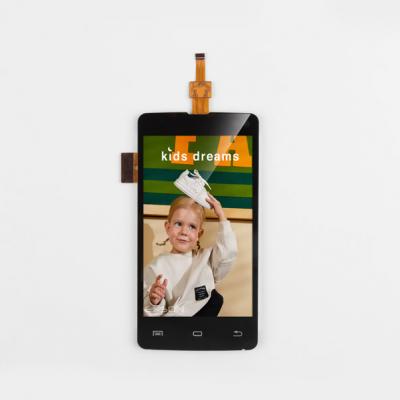We will discuss the viewing angles of industrial LCD screens and how to choose the appropriate viewing angle for your project.
Screen viewing angle refers to the maximum angle at which users can accept the image quality. The reflection of LCD screens is different in all directions, with the brightness being lower when the viewing angle with the screen is smaller in the horizontal direction. The viewing angle is defined as the angle at which the brightness drops to 50%.
The larger the viewing angle of the screen, the wider the viewing range, and the brightness is satisfying when viewing images within the viewing angle; however, the brightness appears insufficient when viewing images outside the viewing angle. This concept is closely related to the gray inversion phenomenon, where users can notice a sudden change in displayed colors when exceeding a certain angle (viewing angle), mainly due to the dominance of gray in the displayed image.
The viewing angle of industrial LCD screens is measured from each of the four directions along the screen's normal axis. In theory, the maximum angle is 90°, and the angle may vary for each measurement direction. The three-dimensional range of angles is referred to as the viewing cone.
The most popular types of industrial LCD screens on the market are TN, VA, MVA, and IPS.
TN LCD screens are the most cost-effective technology. Their angles are mostly narrower compared to other types, but the low price and short matrix response time make up for the smaller viewing cone. To widen the viewing angle, an O-film can be added to the screen. When purchasing TN screens, you should always pay attention to the viewing direction indicated by small angles. It describes from which direction users should view the screen.
VA and MVA types of LCD screens have relatively short response times, wide viewing angles, and high contrast ratios. They fall between TN and IPS types.
IPS matrix technology not only possesses most of the advantages of VA, but also has excellent color reproduction and the highest viewing angle on both axes. The most common drawback of IPS is lower black color depth compared to VA types.
If a project requires a higher viewing angle, LCD screens with a full viewing angle (each axis measuring 178.5° to 180°) should be chosen. In this case, look for MVA and IPS LCD displays.
If price is the most important factor, you can find a cost-optimized option by purchasing TN screens.
Remember to check the correct viewing direction for your application. The simplest rule is to choose a 12 o'clock screen when users view it from the top, and a 6 o'clock screen when viewed from the bottom.
Note: Do not confuse viewing direction with gray inversion. Gray inversion always opposes the viewing direction. For example, a screen facing 12 o'clock will have a color inversion at 6 o'clock.
A compromise solution is to expand the viewing angle for TN LCD screens by adding an O-film. For a wide range of industrial LCD screens with optimal viewing angles, consider our top-quality TFT LCD modules for sale. As trusted custom LCD manufacturers, we provide a variety of options such as MVA and IPS displays for projects requiring a full viewing angle, as well as cost-optimized TN screens for budget-conscious needs. Additionally, our expertise extends to expanding the viewing angle of TN LCD screens through the incorporation of an O-film, offering a compromise solution that meets your specific requirements.
 Exson Tech In-Vehicle LCD Module: Leading a New Chapter in Automotive DisplaysJuly 1, 2024In today's rapidly developing automotive industry, in-car displays have become a key element in enhancing the driving experience and intelligent level. Among many in-car display technologies, LCD ...view
Exson Tech In-Vehicle LCD Module: Leading a New Chapter in Automotive DisplaysJuly 1, 2024In today's rapidly developing automotive industry, in-car displays have become a key element in enhancing the driving experience and intelligent level. Among many in-car display technologies, LCD ...view Application Scope and Technical Characteristics of 7-inch LCD ScreenOctober 31, 2022Now we can see 7-inch TFT LCD screens in many places. Compared with small and medium-sized TFT LCD screens, 7-inch TFT LCD screens are used in more fields. Its scope of application includes: GPS, digi...view
Application Scope and Technical Characteristics of 7-inch LCD ScreenOctober 31, 2022Now we can see 7-inch TFT LCD screens in many places. Compared with small and medium-sized TFT LCD screens, 7-inch TFT LCD screens are used in more fields. Its scope of application includes: GPS, digi...view The Role of Touch Panel Modules in Modern DevicesJanuary 25, 2024In today's fast-paced world, technology plays a vital role in our everyday lives. From smartphones to tablets and even refrigerators, the integration of touch panel modules has revolutionized the ...view
The Role of Touch Panel Modules in Modern DevicesJanuary 25, 2024In today's fast-paced world, technology plays a vital role in our everyday lives. From smartphones to tablets and even refrigerators, the integration of touch panel modules has revolutionized the ...view Advantages of WUXGA TFT Display Over Traditional Screen TechnologiesMay 9, 2024As technology continues to advance, display technology is also changing rapidly. In many screen technologies, WUXGA (Wide Ultra Extended Graphics Array) TFT (thin-film transistor) display with its uni...view
Advantages of WUXGA TFT Display Over Traditional Screen TechnologiesMay 9, 2024As technology continues to advance, display technology is also changing rapidly. In many screen technologies, WUXGA (Wide Ultra Extended Graphics Array) TFT (thin-film transistor) display with its uni...view Touch Panel Module Customization and Design ConsiderationsJanuary 25, 2024In the dynamic landscape of interactive technology, touch panel modules have become the backbone of seamless user experiences. However, the key to unlocking the full potential of these modules lies in...view
Touch Panel Module Customization and Design ConsiderationsJanuary 25, 2024In the dynamic landscape of interactive technology, touch panel modules have become the backbone of seamless user experiences. However, the key to unlocking the full potential of these modules lies in...view Analysis of the Causes of Chromatic Aberration in TFT LCDOctober 27, 2020Some customers will ask us why there is a chromatic aberration in the same TFT LCD screen? The so-called chromatic aberration of a TFT LCD screen means that when two LCDs of the same model are placed ...view
Analysis of the Causes of Chromatic Aberration in TFT LCDOctober 27, 2020Some customers will ask us why there is a chromatic aberration in the same TFT LCD screen? The so-called chromatic aberration of a TFT LCD screen means that when two LCDs of the same model are placed ...view Call us on:
Call us on:  Email Us:
Email Us:  2F-M1 XiaWei Industrial Park, GuanLan, LongHua District, SZ, China
2F-M1 XiaWei Industrial Park, GuanLan, LongHua District, SZ, China